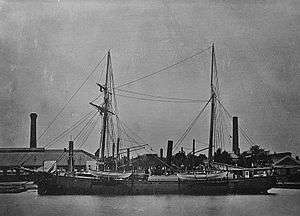USS Periwinkle (1864)
 The Periwinkle as the U.S.S. Polaris, equipped for Arctic exploration. | |
| History | |
|---|---|
| Ordered: | as America |
| Laid down: | date unknown |
| Launched: | 1864 |
| Acquired: | 9 December 1864 |
| Commissioned: | January 1865 |
| Out of service: | October 1872 |
| Struck: | 1873 (estimate) |
| Homeport: | |
| Fate: | crushed in ice pack October 1872 |
| General characteristics | |
| Displacement: | 383 tons |
| Length: | 140’ |
| Beam: | 28’ |
| Draft: | 10’ 6” |
| Depth of hold: | 12’ |
| Propulsion: | steam engine screw-propelled |
| Speed: | not known |
| Complement: | 16 |
| Armament: | two 24-pounder guns |
USS Periwinkle (1864) was a steamer procured by the Union Navy during the final months of the American Civil War. She served the Union Navy’s struggle against the Confederate States of America as a patrol gunship.
After the war, this ship was retained by the U.S. Navy to support the Hall Scientific Expedition to the Arctic Ocean, and during this voyage – under her new name Polaris – she proceeded into Arctic waters, only to have her hull crushed by the ice.
Construction
America, a heavy screw tugboat built at Philadelphia, Pennsylvania, in 1864, was purchased by the Union Navy 9 December 1864 from John W. Lynn; renamed Periwinkle; and commissioned early in January 1865, Acting Master Henry C. Macy in command.
Assigned to river patrol in the Potomac River
The two-masted, schooner-rigged, white oak tug joined the Potomac Flotilla 15 January 1865 as a gunboat, and operated primarily in the Rappahannock River.
In mid-March, a fleet of oyster schooners operating in the area was threatened by a Confederate enemy force, and Periwinkle with USS Morse, blockaded the mouths of the Rappahannock and Piankatank rivers to protect them. The Flotilla also interrupted contraband business between lower Maryland and Virginia, and cleared the rivers of mines, and fought guerillas ashore.
Post-war assignment

After the Civil War ended, Periwinkle continued to serve with the flotilla until June 1865. Next, ordered to Norfolk, Virginia, she operated out of the Norfolk Navy Yard until placed in ordinary during 1867.
Late in 1870, she was selected for service with Charles Francis Hall's North Polar Expedition, and was sent to the Washington Navy Yard for repairs. Renamed Polaris early in 1871, she arrived at New York Navy Yard 9 June 1871 to complete loading of stores and provisions for the expedition. She sailed from the New York Navy Yard in July 1871, Charles F. Hall in command.
Aiming for the North Pole, she reached 82’1 11’ N. latitude, then the furthest point north reached by a vessel. Polaris was caught in the ice on the homeward voyage in October 1872, and carried for some distance before being crushed. Her crew was subsequently rescued, including a party of 18 men led by William F. C. Nindemann, who had debarked to land provisions after the hull of the Polaris had begun to leak, only to have the section of the ice floe they were on break away from the section holding the Polaris. The lost party floated for 196 days and were subsequently rescued separately from the vessel.
See also
- Union Blockade
- United States Navy
- List of United States Navy ships
- William F. C. Nindemann, a seaman on the voyage of the Polaris.
References
- This article incorporates text from the public domain Dictionary of American Naval Fighting Ships. The entry can be found here.